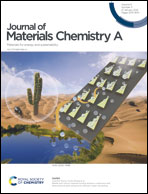Artemisinin-passivated mixed-cation perovskite films for durable flexible perovskite solar cells with over 21% efficiency†
Abstract
High power conversion efficiencies (PCEs) surpassing 20% have been achieved on flexible single-junction perovskite solar cells recently. However, improvements of the open-circuit voltage (VOC) and fill factor (FF), limited by the nonradiative recombination, and the device durability are needed to boost the practical performance further. Herein, we report the use of artemisinin, an herb extract, to passivate the perovskite grains to improve the VOC and FF of flexible PSCs significantly. The incorporation of artemisinin (0.22 mol%) in the perovskite film reduces the film's trap density and thus the nonradiative recombination effectively. As a result, a best PCE of 21.10% is achieved, comparable with state-of-art values of flexible thin-film solar cells (CIGS, CdTe, etc.). VOC reaches 1.126 V, corresponding to a VOC loss of 0.437 V. Moreover, the flexible PSCs incorporated with artemisinin always exhibit excellent stabilities under different aging conditions. Strong interactions between the artemisinin molecules and the uncoordinated Pb2+ ions revealed by theoretical and experimental calculations are responsible for the suppressed formation of new deep-level trap defects, Pb clusters, upon aging.

- This article is part of the themed collection: 2021 Journal of Materials Chemistry A most popular articles


 Please wait while we load your content...
Please wait while we load your content...